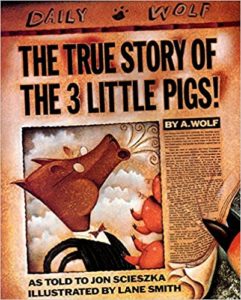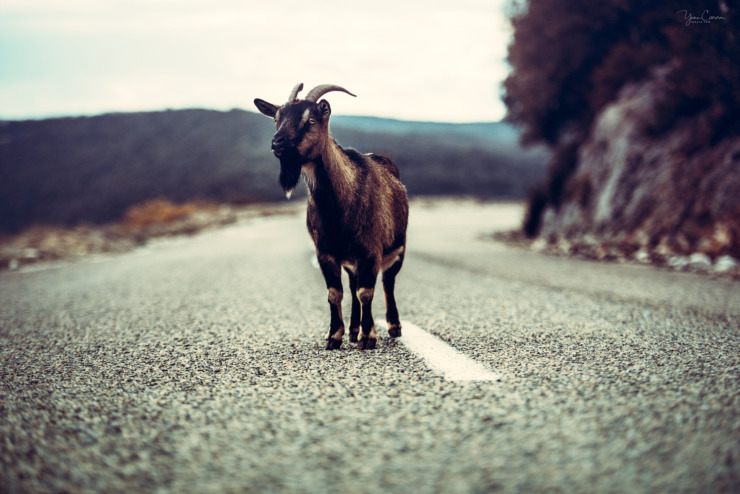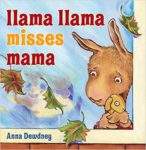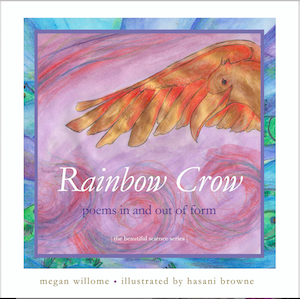The True Story of the 3 Little Pigs (Wolf’s honor!)
Everybody knows the true story of the 3 little pigs. Or at least they think they do. But I’ll let you in on a little secret. Nobody knows the real story, because nobody has ever heard my side of the story.”
Thus begins this fractured fairy tale, (alas, with zero fairies) narrated by Alexander T. Wolf. Al for short. A. Wolf.
Fractured fairy tales restructure and reimagine old stories. Sometimes they change the plot, like in Malinda Lo’s Ash, in which Cinderella lives happily ever after with the Huntress. Sometimes the tales change the character, like in the movie Hoodwinked, in which cool, hip Granny needs no one to protect her. And sometimes the perspective is changed, like in this story.
A. Wolf is here to set the story straight. In short: It’s not his fault. Even though he acknowledges that wolves do “eat cute little animals like bunnies and sheep and pigs,” he says, “If cheeseburgers were cute, folks would probably think you were Big and Bad, too.”

For example, the wolf says he needs to borrow a cup of sugar because he is baking a birthday cake for his dear old granny. But in the mixing bowl, none of the eggs have been broken, and, even worse, a pair of bunny ears are sticking out. The picture lets us know this wolf is not to be trusted.
For the most part, the plot of this fairy tale doesn’t change. All three houses are destroyed. The first two pigs are eaten — “Now you know food will spoil if you just leave it out in the open” — and the wolf gets what he has coming to him. Some versions of this old, old story end in a fairly gruesome manner, but this one ends with A. Wolf being hauled away by the police to jail, aka the Pig Penn.
But the pictures at the end invite us to again reconsider what we know. One illustration is of a newspaper, The Daily Pig, with “All the News That’s Fit For Pigs.” Fit for pigs, not for wolves. One article has a close-up of a wolf’s teeth, the big bad sharp fangs of Canis lupus. But wait, wolves can’t help their teeth, can they? Maybe we need to read a copy of The Daily Wolf to compare and contrast and decide the truth for ourselves.
Or we can just enjoy the story. Even though it is not sweet. Even though it is filled with wolf attitude.
Author Jon Scieszka has written other fractured fairy tales, along with many other books. While working as a teacher, he began to share the stories he was writing with his students. He then took some time off to write and, with illustrator Lane Smith, created A. Wolf’s Tale, which became this book. Here is what he says about the early reactions of publishers to this tale:
Too dark,” they said. “Too sophisticated,” they said. “Don’t ever come back here, okay?” they said.
Eventually Viking Books bought the story, changed the name, and the rest, as they say, is, well, 3 million copies in fourteen languages.
We grownups tend to get ideas about what kinds of books kids will like: this one won an award, or this one teaches important lessons, or this one has a corresponding TV show or movie. And all those reasons may be valid. But they are not the only reasons a child may want to read a book. Maybe they want a story told from the villain’s perspective. Maybe they want to laugh as the wolf waves a white handkerchief embossed with fuzzy pink sheep. Maybe every tale holds multiple stories inside it.
Next Month’s Selection
It’s back to school time! For our next Children’s Book Club, Friday, September 10, we’ll read Anna Dewdney’s Llama Llama Misses Mama and find out what happens when little Llama goes to school. Put on your rhyming caps! And be ready to dip into other Llama books too.
Photo by Yann Cœuru, Creative Commons, via Flickr. Post by Megan Willome.
Browse more Children’s Book Club
“Megan Willome has captured the essence of crow in this delightful children’s collection. Not only do the poems introduce the reader to the unusual habits and nature of this bird, but also different forms of poetry as well.”
—Michelle Ortega, poet and children’s speech pathologist
- Perspective: The Two, The Only: Calvin and Hobbes - December 16, 2022
- Children’s Book Club: A Very Haunted Christmas - December 9, 2022
- By Heart: ‘The night is darkening round me’ by Emily Brontë - December 2, 2022



Leave a Reply